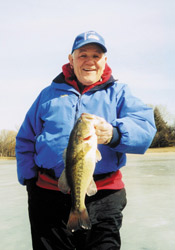Three Step Plan for Icing Bass: Ice Fishing for Sportfish
Posted by Walt & Poppee Matan on Jan 3rd 2019
Posted by Walt & Poppee Matan on Jan 3rd 2019
Largemouth and smallmouth bass can be readily caught through the ice. They are tremendous sport fish that are ridiculously strong under the ice. Your favorite ponds and lakes that produce bluegill and crappie will also give up largemouth in the same general areas. Smallmouth bass should be targeted in gravel and rock areas of lakes that are known smallmouth producers in the open water season.
If you want to ice more bass this winter, then you need my three-step plan — 3 Holes + 3 Poles + 3 Different Jigs = Bass
 Largemouth Bass
Largemouth Bass
Shallow weedy bays are prime areas that hold largemouth bass. Bass will roam the weed edges in search of an easy meal, so you need to drill your three holes in and around the weed edges.
The easiest way to find weed edges is with and underwater camera. Once on the spot, you can set the camera to automatically rotate or zero in on your jig.
A long time ago my good friend Chuck Thompson showed me the three-rod technique. It's basically the same as in open water fishing where you use several rods rigged with different style lures until you find the hot one. When ice fishing, the bass will either be aggressive, interested or neutral. So I like to have three ice rods rigged with three different jigs to reflect that.
To make fishing easier, dark flip-over tents to shield from the wind and detect bites easier.
Aggressive fish want a big aggressive spoon. Vertiglow Tackle’s 1/8-ounce Lightnin' Spoons work great when aggressively jigged. You need to jig your rod violently and then pause for several seconds. The jigging motion will call the bass in and they usually strike on the pause.
 Interested fish will come up and take a peek at the spoon, but then shy away. If you are using a camera you will see this time and again, but if you have a second rod rigged, now is the time to pull the first rod out of the hole and drop down the next jig. For this technique I prefer a Custom Jigs & Spins Demon size 4. You can jiggle the Demon a little less violently than the Lightnin’ Spoon while raising and lowering you rod in six-inch increments.
Interested fish will come up and take a peek at the spoon, but then shy away. If you are using a camera you will see this time and again, but if you have a second rod rigged, now is the time to pull the first rod out of the hole and drop down the next jig. For this technique I prefer a Custom Jigs & Spins Demon size 4. You can jiggle the Demon a little less violently than the Lightnin’ Spoon while raising and lowering you rod in six-inch increments.
For completely non-aggressive bass, it's time to pull out a size 6 Shrimpo. The Shrimpo has a Finesse Plastic tail and is loaded with action. Just holding the rod in your hand will cause the Shrimpo to quiver and a bass to strike!
Adding bait to these jigs is sometimes necessary. I'’ll use minnow heads, wax worms or butter worms. I'll break the minnow a little longer past the head and kind of "smoosh" it for added attraction. Minnow heads work nicely when added to the Lightnin' Spoon and the big Demon. I’ll use three or four wax worms or butter worms sometimes also. One trick is to shred them with another hook so that little pieces of tail quiver as you jig.
 Smallmouth Bass
Smallmouth Bass
Smallmouth bass will hold in completely different areas than largemouth. I like to fish lakes like Lake Geneva in southern Wisconsin for smallmouth. On Geneva, the smallmouth will hold off the many points that jut out into the lake. These are rock/gravel/boulder points. I've caught smallmouth as shallow as four feet and as deep as 30 feet... off the same point, on the same day!
Early and late in the day, the bass will move shallow and they will stay shallow as long as the day remains cloudy. I use the same three-rod/three-jig combos as for largemouth bass. If you lower the camera down the hole it is pretty easy to spot these smallmouth in Geneva’s ultra-clear water and you can focus right in on the fish depth zone.
If you want to try something different this winter give bass fishing a try. You'll be rewarded with incredible action, but please practice catch and release.